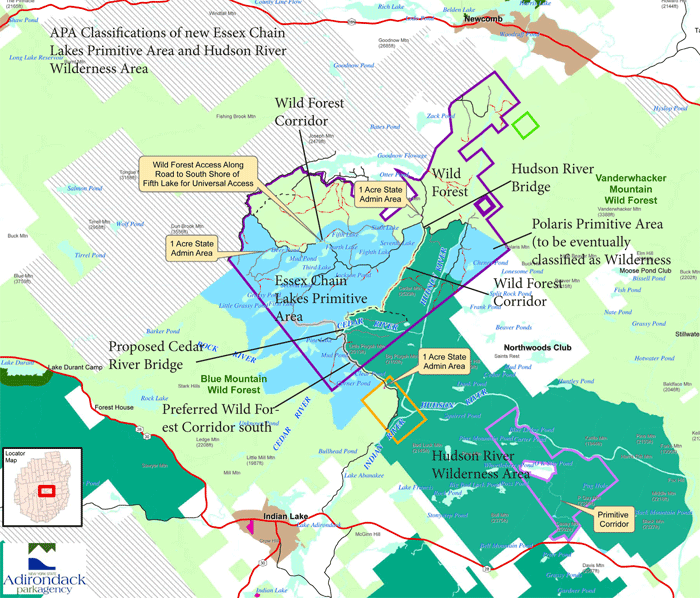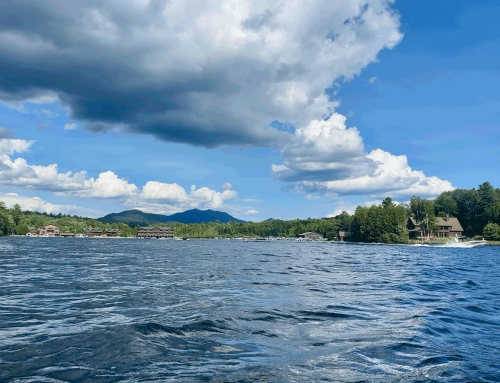Within the scope of the 10-day public comment period around the classification decision for the Essex Chain Lakes and Hudson River Gorge areas, a joint letter was submitted to put the APA and DEC on notice about procedural, regulatory, and legal lapses and deficiencies. While there is much to cheer in the APA’s actions, long-term Forest Preserve management precedent will be established by this action.
PROTECT and other groups put in the letter below to the APA during the public comment period. Click here for a copy of this letter.
See additional PROTECT comments on the APA’s decision here. See a map below that details the APA’s classification recommendation to the Governor.
Here is the letter to the APA:
December 27, 2013
Terry Martino, Executive Director
NYS Adirondack Park Agency
1133 Rt. 86, P.O. Box 99
Ray Brook, NY 12977
Re. Public Comment on APA’s Resolution and SEIS, 2013 Classification Package
Dear Terry:
We congratulate the Agency on its important classification actions taken on December 13, and on the considerable staff, State Land Committee and overall Agency efforts to abide by the State Land Master Plan and its paramount consideration of natural resource protection in making its determinations. Pursuant to formal notice of these actions in the December 18 Environmental Notice Bulletin, we offer our collective critique within the 10-day comment period.
While there is much to support in the APA’s actions, we are troubled by procedural, regulatory and legal deficiencies and questions resulting from them, such as:
• The Final Supplemental Environmental Impact Statement (FSEIS) failed to include any analysis whatsoever of actual or potential impacts resulting from the proposed alternative, i.e., the proposed motorized Wild Forest corridor through the center of the areas, a connecting snowmobile bridge over the Scenic Cedar River, and other recommended regulatory changes and Master Plan amendments
• The legal analysis of the preferred alternative should be conducted by the APA, yet is improperly deferred to the NYS DEC with the preferred alternative resting upon certain regulatory outcomes at the Department. We ask the Agency for a formal legal opinion and analysis of its preferred alternative;
• The APA released its decision just 5 days prior to its meeting, failing to give its members and the public meaningful opportunity for evaluation and comment in advance of a final decision.
Our more detailed comments follow.
1. Primitive Areas: The organizations signing this letter will continue to advocate for a Wilderness classification for the Essex Chain Lakes tract because we believe the area as a whole meets Wilderness classification guidelines. However, we also acknowledge that the Essex Chain Lakes /Pine Lake/Polaris Mountain Primitive Areas as proposed in your Resolution comply with the Adirondack Park State Land Master Plan directive that natural resource considerations shall be the APA’s paramount consideration, and that classifications are to be determined by physical, biological and intangible considerations, taking into account established facilities, uses and policies. APA staff and the State Land Committee of the Agency acted properly on their recognition that the Chain Lakes have regional significance due to their connectivity and biological diversity, and have an especially limited capacity to withstand intensive human uses, requiring a form of wilderness management. We especially appreciate that the proposed Essex Chain Lakes Primitive area is extended ¼ mile north of the Chain Lakes to provide the Chain with an extra measure of protection and wilderness stewardship.
2. Hudson Gorge Wilderness Area: Wilderness re-classification and unified management for the 23,500 acres centered on the Hudson Gorge, and including OK Slip Falls and parts of the Indian River tract, helps to consummate an objective of longstanding duration, and helps fulfill the vision of the APA’s Peter Paine and George Davis and of conservation leaders, such as Paul Schaefer and many others. The APA’s actions in this regard were proper and necessary, and afford the NYS DEC the opportunity to manage the upper Hudson according to the highest standards, and citizens from around the world to experience a wilderness resource of global significance.
3. Wild Forest Corridor: At its September, 2013 meeting, APA State Land Committee Chair Richard Booth asked the staff to prepare a legal memo and analysis of the various classification alternatives. That request was not honored, nor did APA produce the necessary legal analysis as part of its SEIS. Instead, APA improperly left the legal analysis of whether or not the construction of a snowmobile bridge over the Scenic Cedar River would be authorized under existing regulations (6 NYCRR Part 666) to the NYS DEC, and also failed to legally analyze whether or not a motorized corridor south of the Cedar River would violate regulations pertaining to Wild River corridors.
Your actions also appear to violate SEQRA by failing to assess alternative actions that would:
• avoid amendments to the aforementioned Wild Scenic and Recreational River regulations needed to build a new motorized bridge over the Scenic Cedar River;
• avoid placing motor vehicles within a half-mile corridor of the Wild Upper Hudson River;
• avoid amendments to the State Land Master Plan to allow a bridge over the Cedar River to be constructed with other than solely natural materials.
Your final actions also fail to conduct alternatives analysis of the existing snowmobile community connector (Type II) trail between Indian Lake and Newcomb utilizing Conservation Easement lands west of the Essex Chain Lakes, and whether or not that trail duplicates the Wild Forest snowmobile corridor preferred along the Camp 6 and Chain Lakes Roads North and South, or the alternative route west and north of the Cedar River. Your final actions fail to assess whether or not your preferred alternative and a snowmobile corridor along the Chain Lakes Road North and South would violate those parts of the Management Guidance for Snowmobile Siting, Construction and Maintenance on Forest Preserve Land in the Adirondack
Park whereby Class II Connector Trails are “always located as close as possible to motorized travel corridors, and only rarely are any segments of them located further than one mile away from the nearest of these corridors. They are not duplicated or paralleled by other snowmobile trails.”
We also want to point out that the continuing existence of this Wild Forest Corridor would forever condemn the adjoining Primitive Areas to remain Primitive rather than becoming Wilderness as the SLMP envisions for this classification.
4. Polaris Bridge: By retaining the Polaris Bridge across the Hudson within the proposed Wild Forest with the intent of maintaining the bridge for future motorized uses, APA’s classification action detracts significantly from the potential and management of the Hudson Gorge Wilderness Area. The bridge was permitted by APA and DEC in the early 1990’s as a temporary structure within a Scenic River corridor in order to access forest products on the east side of the Hudson. Its large abutments or piers always improperly impeded the river’s flow. Given the sunsetting of the Polaris Club, the removal of its leasehold structures, and the subsequent classification of the Polaris Mountain Primitive Area on the east side of the river, there will be no private interests served by the bridge after 2018 (or earlier). The bridge is not needed to serve non-motorized recreational users of the river, nor is it needed to create a snowmobile connection to Minerva. If allowed to remain, the bridge will become a management and maintenance nuisance and expense, and facilitate illegal motorized uses on both sides of the river requiring frequent Forest Ranger patrols and enforcement actions by the State. Its presence violates the purpose and intent of the Hudson Gorge Wilderness Area and the future Polaris Mountain Primitive Area and it would prevent this Scenic section of the Hudson River from becoming a Wild river corridor. The bridge ought to be placed within the Wilderness or Primitive areas and be removed as soon as the Polaris Club lease expires in 2018, or preferably sooner.
5. Legal Opinion: Prior to releasing the classification package to the Governor, we believe the APA is obligated to prepare a legal analysis of its preferred alternative and actual and potential environmental impacts resulting from it. We do not believe the APA’s deferring these questions and alternatives to the NYS DEC is the appropriate response to its obligations under the Master Plan and under SEQRA. We ask for a legal opinion on these matters from Agency Counsel.
Thank you for taking into account our comments, and our request for a formal legal opinion.
Protect the Adirondacks
Adirondack Wild
The Sierra Club Atlantic Chapter






